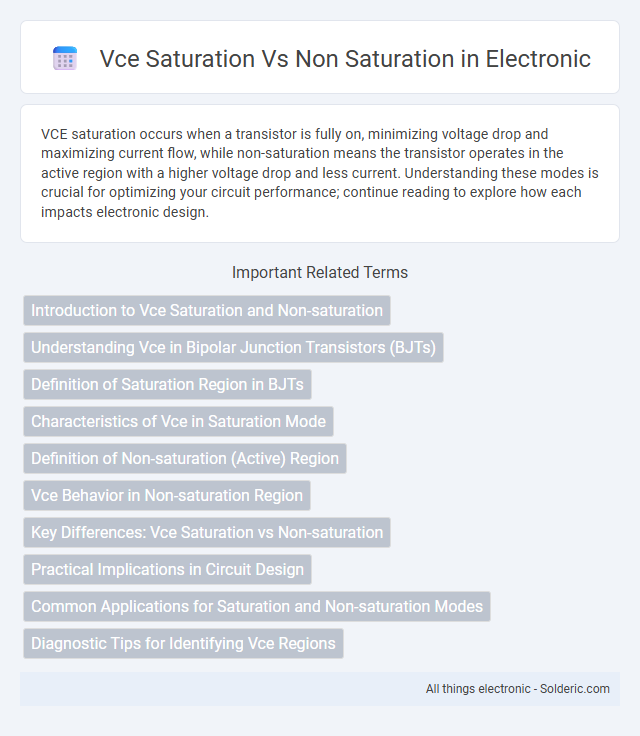VCE saturation occurs when a transistor is fully on, minimizing voltage drop and maximizing current flow, while non-saturation means the transistor operates in the active region with a higher voltage drop and less current. Understanding these modes is crucial for optimizing your circuit performance; continue reading to explore how each impacts electronic design.
Comparison Table
| Parameter | Vce Saturation (Vce(sat)) | Vce Non-Saturation |
|---|---|---|
| Definition | Voltage across the collector-emitter when transistor is fully ON | Voltage across collector-emitter when transistor operates in the linear region |
| Voltage Level | Low voltage (typically 0.1V to 0.3V) | Higher voltage, varies with load and input |
| Operation Mode | Saturation region (transistor acts like a closed switch) | Active region (transistor acts as an amplifier) |
| Collector Current | Maximum collector current for given base current | Collector current proportional to base current and Vce |
| Power Dissipation | Low power dissipation due to low Vce | Higher power dissipation due to higher Vce |
| Usage | Switching applications (ON state) | Amplification and analog circuits |
Introduction to Vce Saturation and Non-saturation
VCE saturation occurs when a transistor is driven fully on, resulting in minimal voltage drop across the collector-emitter junction (typically around 0.2V), allowing maximum current flow. In contrast, VCE non-saturation means the transistor is operating in its active region, with a higher voltage drop and controlled current flow. Understanding these states is crucial for designing efficient switching circuits and amplifiers.
Understanding Vce in Bipolar Junction Transistors (BJTs)
Vce (voltage between the collector and emitter) plays a key role in the operation of Bipolar Junction Transistors (BJTs), distinguishing saturation from non-saturation states. In the saturation region, Vce is minimal, typically around 0.1 to 0.3 volts, indicating that both the base-collector and base-emitter junctions are forward biased, enabling maximum current flow through the transistor. In contrast, the non-saturation (active) region has a higher Vce, usually above 0.3 volts, where the base-collector junction is reverse biased, allowing controlled amplification by the transistor.
Definition of Saturation Region in BJTs
The saturation region in BJTs occurs when both the base-emitter and base-collector junctions are forward-biased, allowing maximum current flow from collector to emitter. In saturation, the collector-emitter voltage (Vce) drops to a low value, typically close to 0.2V for silicon transistors, indicating the transistor is fully "on." This contrasts with the non-saturation or active region, where the collector-base junction is reverse-biased, enabling controlled amplification rather than maximum conduction.
Characteristics of Vce in Saturation Mode
In saturation mode, the Vce voltage drops to a minimal value, typically around 0.1 to 0.3 volts, indicating the transistor is fully on and allowing maximum current flow through the collector-emitter junction. This low Vce results in minimal power dissipation and efficient switching performance, ideal for digital applications requiring a clear distinction between on and off states. Your circuit benefits from reduced heat generation and enhanced reliability when operating with a transistor in saturation mode.
Definition of Non-saturation (Active) Region
The non-saturation (active) region in a bipolar junction transistor (BJT) occurs when the collector-base junction is reverse-biased, allowing the transistor to amplify signals effectively. In this region, the collector-emitter voltage (Vce) is higher than the saturation voltage, ensuring the transistor operates as an amplifier rather than a switch. Understanding your transistor's Vce in the active region is crucial for designing circuits with precise current gain and stable operation.
Vce Behavior in Non-saturation Region
In the non-saturation region, Vce remains sufficiently high, ensuring the transistor operates in the active region where the collector current is primarily controlled by the base current. Your transistor maintains a stable Vce, preventing the device from entering saturation and allowing linear amplification. This behavior is critical for analog circuits, as it preserves the proportional relationship between input and output signals.
Key Differences: Vce Saturation vs Non-saturation
Vce saturation occurs when a transistor is fully on, with the collector-emitter voltage (Vce) at its minimum, resulting in maximum current flow and low voltage drop, ideal for switching applications. Non-saturation means the transistor operates in the active region, where Vce is higher, and the device functions as an amplifier rather than a switch. Your choice between Vce saturation and non-saturation impacts efficiency, power dissipation, and the linearity of the transistor's performance.
Practical Implications in Circuit Design
Vce saturation vs non-saturation states significantly impact transistor switching speed and power dissipation in circuit design. Operating a transistor in saturation minimizes voltage drop, improving current drive but increases storage time, slowing switching performance. Understanding these trade-offs helps you optimize circuits for efficiency and speed based on the desired application.
Common Applications for Saturation and Non-saturation Modes
Vce saturation mode is commonly used in switching applications such as power transistors and digital logic circuits where the transistor acts as a switch, providing minimal voltage drop and maximum current flow. Non-saturation mode is preferred in analog amplifier circuits where linearity and precise voltage control are critical, allowing the transistor to operate within the active region for accurate signal amplification. Industrial control systems and signal processing frequently utilize both modes to balance efficiency and fidelity in circuit design.
Diagnostic Tips for Identifying Vce Regions
Vce saturation occurs when the transistor enters the saturation region, causing the collector-emitter voltage (Vce) to fall near its minimum, typically below 0.3V, which indicates the device is fully on. Identifying non-saturation regions involves observing Vce values significantly higher than saturation voltage, often above 0.7V, signaling the transistor is operating in the active region. To diagnose these regions accurately, measure Vce under load conditions and compare against expected saturation thresholds to determine if Your transistor is switching properly or requires adjustment.
Vce saturation vs non saturation Infographic

 solderic.com
solderic.com